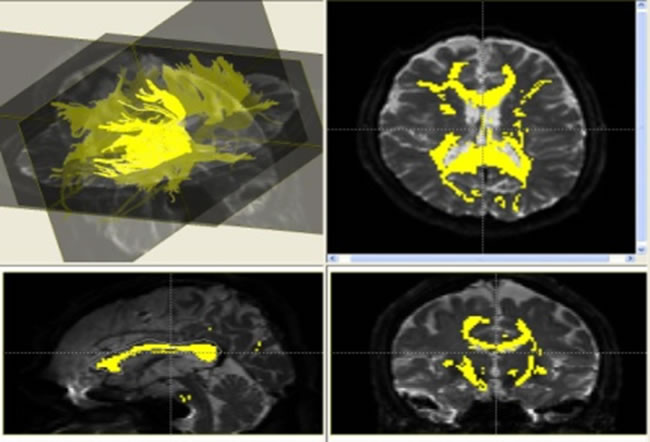|
|
|
Research
Connectivity and Network Analysis in Neurodegenerative Disease
|
Magnetic Resonance-based Imaging |
MRI is a noninvasive medical imaging technique to visualize the living brain.
Resting state fMRI is used to know what happens in the brain at rest in terms of the brain activity.
Diffusion Tensor Imaging (DTI) is a structural imaging especially for the structure and characteristics of the white matter in the brain.
fMRI and DTI have been used to reveal a connectivity profile of the brain for the complex network analysis.

[ Sensory-motor network in resting state obtained using fMRI. ]

[ Tractographic reconstruction of corpus callosum (yellow) via diffusion tensor image. ]
There are other functional imaging technique to image an activity of the brain, e.g. EEG and NIRS. MRI could be combined with these methods to overcome limitations of each imaging modality.
|
Neurodegenerative Disease |
Neurodegenerative diseases refers neurological disorders resulting from degenerative processes, progressive loss of structure or function of neurons, and includes Alzheimer's disease (AD) which is the most common cause to evoke the dementia and Parkinson's disease (PD) characterized by motor dysfunction.
(1) Connectivity in the Neurodegenerative disease brain
Progressive deterioration of the brain function and the severity of symptoms would be reflected by gradual changes in the structural and functional connectivity of the brain.

[ Enhanced connectivity between cerebellum (red) and primary motor cortex in PD. ]
Structure and function of the brain are closely related to each other and changes in the brain are also related to symptoms or decline in cognitive function in brain disease patients. If we characterize a specific connectivity pattern in certain brain disease or severity stage, then we can diagnose the disease even in early stage by analyzing connectivity pattern of the brain as a marker without any apparent symptom.
(2) Brain Network Analysis
Using fMRI and DTI data, structural and functional changes in the brain with disease could be analyzed to characterize network properties, such as path length, efficiency, robustness, and modularity. In case of AD, for example, the disease progression from healthy and amnestic mild cognitive impairment to AD can be analyzed in network point of view, disruption or inefficiency of the network.
|
|
|
|